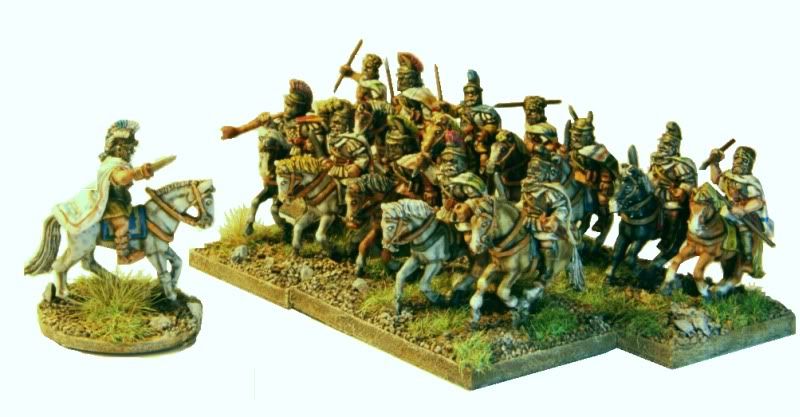Page 1 of 1
Wedge formation cavalry in FoG
Posted: Wed Jan 25, 2012 10:31 pm
by Pablo1869
There is my new Odrysian Heavy Cavalry. I can use them in line, rectangle or wedge formation cause one base is divide for two parts.
Wedge formation was popular in ancient army. More photos and information you can find in my blog:
http://hieros-lochos.blogspot.com/2012/ ... art-i.html
Could you have any idea how to fight wedge formation in FOG rules. I want to change combat cavalry rules for more historical fighting.

Posted: Thu Jan 26, 2012 5:32 pm
by willb
Wedges were usually formed by smaller tactical units than those used for FOG. See Asclepiodotus "Tactics part VII -The Cavalry". As such each base would consist of one or more wedges. Nice looking figures.
regards,
Bill
Posted: Thu Jan 26, 2012 10:49 pm
by Pablo1869
Thanks Bill.
It's clear that small cavalry formation like ila or squadron used wedge. About this small unit formation wrote Asclepiodotus in "Tactics",
but he didn't write about fighting big cavalry formation like regiment or brigade. I think that is naturally that they used the same formation like small units.
See in my post about rhomboid formation in Thessaly.
http://hieros-lochos.blogspot.com/2011/ ... sc-ii.html
Posted: Sat Jan 28, 2012 2:18 pm
by ShrubMiK
Pablo1869 wrote:
I think that is naturally that they used the same formation like small units.
The key word there seems to be "think" - and as it happens I myself think you are wrong!
Formations don't just scale up seamlessly. The whole purpose of a wedge formation is presumably that it is quite pointy. I personally wouldn't count 1000 soldiers in a in 5 ranks of 198,199,200,201,202 as a "wedge"

To keep it pointy as you add more soldiers to the formation means it is inevitably going to get deeper and deeper, and there is presumably some number of ranks past which adding more on the back is not as effective as taking those soldiers and deploying them in another small wedge alongside. Exactly what formation are you proposing that 1000 soldiers (which is about what a 4-base BG represents) should be in to both be a) effective as a fighting force on a typical ancient battlefield, and b) different enough in behaviour to justify special rules?
Posted: Sun Jan 29, 2012 2:09 am
by willb
The largest unit that I know of to use the wedge formation was the Byzantine Clibanophoroi, a unit of 504 men. Alexander the Greats's Companion cavalry also used the wedge, but I would have to verify whether the wedges were formed by each Ile or the sub-units of the Ile. Note that base depths are greatly distorted due to the need to fit the figures on a base. For 25mm figures, the game scale would make each infantry base about 250 men and the frontage per man would be about 1mm. The scale depth of an infantry base would be about 4mm to 8mm depending on army and tactical formations. Cavalry would occupy a depth of about 4mm per rank giving a scale base depth of 16mm per base. The Byzantine wedge had a front rank of 20 men and each successive rank increased the frontage by four. Other rule sets combined two bases into a single double depth base for wedge formations, so that figures could be mounted in a wedge formation, but still maintain the full base frontage. Since FOG game mechanics require matching/aligning bases, creating a wedge formation with non-standard base widths could result in problems with the game mechanics. Note also, that the rules require specified base frontages while allowing some variation in base depths to accommodate figures.
Posted: Sun Jan 29, 2012 3:24 pm
by ShrubMiK
I've always assumed Alexander's companion ilai each formed a separate wedge, since ilai seem to be tactical rather than purely administrative units. But they were not more than 300 strong? So again correspond to a single base in FoG.
The Byzantine wedges I think were deeper and hence larger than the standard because they added archers as well and were employed slightly differently, the "shock" troops making up the front and flanks of the ofrmation being armed and armoured differently.
The "other" rule set now represents Hellenistic wedges as single bases, with significant advantages and disadvantages over non-wedges, whilst the Byzantine Klibanophoroi are as you describe Will a double base.
Going back to the original post, I realise I probably sounded a bit harsh in my response!
It would be interesting to add some rules for wedges into FoG, and of course there is no reason why for representative purposes they shouldn't be shown as a singel wedge comprising 4 bases even if the BG is assumed to really represent several subunits attacking simulatenously in smaller wedges. One of the things I was hoping for from FoG v2 was some additional formations rules to add a bit of richness into the unit types and behaviour of different armies, and it seemed to work quite well in FoG:R.

